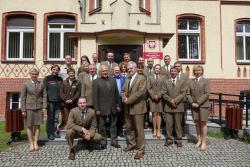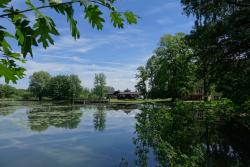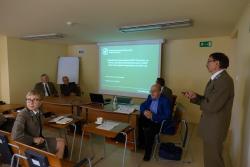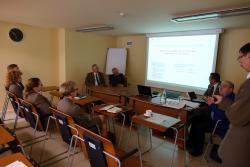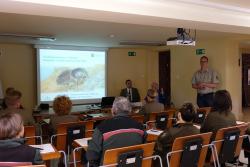 Asset Publisher
Asset Publisher
Polish forests
Poland is in the European lead, while concerning the area of all forests. They cover about 29,2 % of the country territory, and grow within the area of 9,1 million hectares. The overwhelming majority of the forests is state owned, of which almost 7,6 million hectares are managed by the State Forests National Forest Holding..
The number of Polish forest is still growing. The forestation rate of the country has increased from 21 % in 1945 to 29,2 % at the moment. Between 1995 and 2008, the forest area increased by 310 thousand ha. The basis for afforestation works is the "National Programme for Increasing the Forest Cover" (KPZL), assuming an increase of the forestation rate up to 30 % by 2020 and up to 33 % by 2050. Polish forests abound in flora, fauna and fungi. 65 % of the total number of animal species live there.
The forests grow in our country on poor soils, mainly because of the development of the agriculture in previous years. It influences the distribution of the types of the forest sites in Poland. Over 55 % of the forest areas is covered with coniferous forests. In other areas, there are forest sites, mainly the mixed ones. Their small part constitute alder and riparian forests – not more than 3 %.
In the years 1945 – 2011 the area of natural deciduous tree stands within the area of the State Forests National Forest Holding increased from 13 to 28,2 %.
Within the lowlands and uplands the most often occurring tee species is pine. It covers 64,3 % of the forest area of the State Forests National Forest Holding and 57,7 % of private and commune forests. In the mountains the predominant species is European spruce ( in the west) and European spruce with beech (in the east). Domination of pine is the result of carrying on sustainable forest management in the past. Once, the monocultures (crops or cultivations of one species) were the answer to the great demand of industry for wood. Such forests appeared to be quite fragile to climatic factors. They also were often the prey of pests' expansion.
In Polish forests, the share of other tree species, especially deciduous trees have been systematically increasing. The foresters have stepped aside from monocultures – that is why, they try to fit specific species of the forest stand to the natural stand, that would be proper for the given area. Thanks to that, in the years 1945 – 2011, the area of the deciduous tree stands within the lands of the State Forests National Forest Holding increased from 13 to 28,2 %. There occur more and more frequently the following tree species: oaks, ashes, maples, sycamore maples, elms, but also birches, beeches, alders, poplars, hornbeams, aspens, tilias and willows.
Our forests are the most often represented by the forest stands aged 40 to 80 years. The average age of the forest equals 60 years. More and more trees are of big size at the age over 80 years. Since the end of the Second World War, the forests' area has increased up to almost 1,85 million hectares.
Raport o stanie lasów w Polsce 2012
 Asset Publisher
Asset Publisher
Spotkanie leśników polskich i niemieckich w Nadleśnictwie Wymiarki 29.05.19r.
Spotkanie leśników polskich i niemieckich w Nadleśnictwie Wymiarki 29.05.19r.
W dniu 29 maja 2019r. w centrum spotkań leśników polskich i niemieckich w Wymiarkach odbyła się kolejna konferencja z udziałem leśników z Polski oraz z Niemiec.
Tematyką spotkania były aspekty związane z ochroną lasu i ochroną p-poż w lasach. Gości Niemiec (lasy Brandenburgii i Saksonii), pracowników Dyrekcji LP z Zielonej Góry, Szczecina oraz Wrocławia, pracowników ZOL-u z Łopuchówka, Wrocławia i Szczecinka, oraz przedstawicieli kilku Nadleśnictw przywitał w imieniu Nadleśniczego Zastępca Dyrektora RDLP w Zielonej Górze Pan Krzysztof Poczekaj. W swojej wypowiedzi podkreślał istotę oraz zasadność takich transgranicznych spotkań i współpracy. Następnie głos zabrała Naczelnik Wydziału Gospodarki Leśnej Pani Marta Wiler, która przedstawiła zarys tematyczny spotkania.
Później głos zajmowali kolejno przedstawiciele ZOL-i, specjaliści - leśnicy z Niemiec oraz pracownicy RDLP w Zielonej Górze, Szczecinie oraz we Wrocławiu.
Spotkanie miało na celu przeanalizowanie ubiegłego roku pod kątem zagrożenia i zabiegów zwalczania od szkodliwych owadów a także statystki pożarów. Dodatkowo omówiono prognozy zagrożenia na 2019 rok w d-nach iglastych jak i liściastych w Polsce i w Niemczech. Przypomniano metodykę prognostyczną i zapobiegawczą stosowaną w Polsce oraz w Niemczech. Po zakończeniu części prezentacyjnej rozpoczęto dyskusję oraz zadawanie pytań. Na zakończenie Z-ca Dyrektora RDLP Pan Krzysztof Poczekaj podziękował za świetną współpracę i zachęcił do kolejnych spotkań.
Nadleśnictwo dziękuje również za obecność byłemu Nadleśniczemu Nadleśnictwa Wymiarki Panu Edwardowi Koszałce, który zainicjował trwajcy już kilka lat cykl spotklań leśników z Polski i Niemiec.
autor zdjęć: Jakub Kazimir


 fot. Paweł Fabijański
fot. Paweł Fabijański
 fot. Paweł Fabijański
fot. Paweł Fabijański
 fot. Paweł Fabijański
fot. Paweł Fabijański

